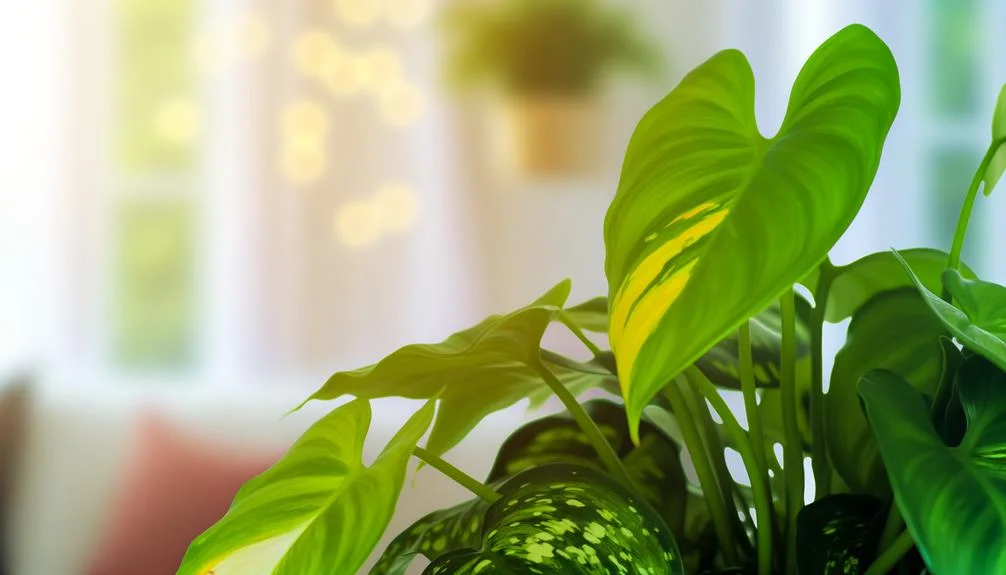What Causes Yellow Spots on a Philodendron Xanadu?
Yellow spots on a Philodendron Xanadu can result from various issues. Pests like spider mites, aphids, and mealybugs disrupt the plant's physiology through sap feeding, leading to chlorosis.
Fungal infections from Phytophthora, Pythium, and Alternaria species thrive in poorly-drained soils, causing yellow chlorotic spots. Overwatering creates anaerobic soil conditions, impairing root respiration, while underwatering results in dehydration.
Nutrient deficiencies, particularly of nitrogen, magnesium, and iron, lead to chlorosis and yellowing. Improper light conditions, whether insufficient or excessive, hinder chlorophyll synthesis.
Addressing these factors can prevent yellow spots and support plant health. Continue exploring to find effective solutions for each issue.

Key Takeaways
- Sap-feeding pests like spider mites, aphids, and mealybugs cause yellow spots by disrupting the plant's physiological processes.
- Fungal infections from Phytophthora, Pythium, and Alternaria species can create yellow spots due to root rot and necrotic leaf lesions.
- Overwatering leads to waterlogged soil, impairing root respiration and causing yellow spots; underwatering results in dehydration and necrotic spots.
- Nutrient deficiencies, such as nitrogen, magnesium, and iron, result in various forms of chlorosis manifesting as yellow spots on leaves.
- Inadequate light conditions, including insufficient or excessive sunlight, hinder chlorophyll synthesis or cause photodamage, leading to yellow spots.
Pests and Insects

One primary cause of yellow spots on Philodendron Xanadu is the infestation by pests and insects, such as spider mites, aphids, and mealybugs, which can disrupt the plant's physiological processes.
These arthropods feed on the plant's sap, compromising its ability to photosynthesize efficiently. Evidence indicates that their feeding activity leads to chlorosis, a condition marked by the yellowing of leaf tissue due to chlorophyll loss.
Analytical observations reveal that spider mites, in particular, create minute punctures, causing localized damage that manifests as yellow spots. Aphids and mealybugs secrete honeydew, fostering mold growth and further inhibiting photosynthesis.
Regular monitoring and integrated pest management strategies are essential to mitigate these infestations and maintain the plant's health.
Fungal Infections
In addition to pest infestations, fungal infections represent another important cause of yellow spots on Philodendron Xanadu leaves, often resulting from pathogens such as Phytophthora, Pythium, and Alternaria species.
These fungi thrive in moist, poorly-drained soils, leading to root rot and compromised plant health. Phytophthora and Pythium primarily attack the root system, causing systemic issues that manifest as chlorotic spots on foliage. Alternaria, on the other hand, directly infects the leaves, creating necrotic lesions surrounded by a yellow halo.
Effective management involves ensuring proper soil drainage, maintaining ideal humidity levels, and applying fungicidal treatments when necessary. Monitoring environmental conditions and implementing preventative measures can greatly reduce the incidence of these harmful fungal infections.
Watering Issues

Improper watering practices are a primary contributor to the development of yellow spots on Philodendron Xanadu leaves. Overwatering can lead to waterlogged soil, which creates anaerobic conditions that impair root respiration and nutrient uptake. This physiological stress manifests as chlorosis, evidenced by yellow spotting.
Conversely, underwatering results in dehydration, causing the foliage to develop necrotic spots due to cellular damage. Studies indicate that consistent moisture levels, achieved through a well-draining potting mix and appropriate irrigation schedule, are critical for best leaf health. Monitoring soil moisture using hygrometers and ensuring drainage can mitigate these issues.
A balanced watering regimen is crucial to prevent both hydric stress and its symptomatic yellow leaf spots.
Nutrient Deficiencies
Nutrient imbalances, particularly deficiencies in essential elements such as nitrogen, magnesium, and iron, can lead to chlorotic manifestations including yellow spots on Philodendron Xanadu leaves.
Nitrogen deficiency often results in general chlorosis, where older leaves exhibit yellowing due to impaired chlorophyll synthesis.
Magnesium deficiency typically manifests as interveinal chlorosis, with veins remaining green while the leaf tissue turns yellow.
Iron deficiency, often exacerbated by high soil pH, causes new leaves to appear yellow with green veins, a condition known as iron chlorosis.
Diagnostic soil testing and tissue analyses are recommended to accurately identify specific nutrient deficiencies.
Corrective measures may include the application of balanced fertilizers or pH adjustments to optimize nutrient availability and plant health.
Light Conditions

Beyond nutrient imbalances, subpar light conditions notably contribute to the development of yellow spots on Philodendron Xanadu leaves. Insufficient light can hinder chlorophyll synthesis, resulting in chlorosis and subsequent yellowing. Conversely, excessive direct sunlight can cause photodamage, manifesting as yellow or bleached spots due to cellular degradation.
Best light exposure for Philodendron Xanadu entails bright, indirect light, which facilitates proper photosynthetic activity without inducing photoinhibition. Empirical studies indicate that maintaining consistent light intensity and duration is essential for leaf health. Utilizing tools such as light meters can offer precise assessments, ensuring that plants receive adequate illumination.
Analyzing light-related variables and adjusting them accordingly can prevent the occurrence of yellow spots, thereby preserving the aesthetic and physiological integrity of the plant.
Conclusion
In summation, the presence of yellow spots on Philodendron xanadu can be attributed to a multifaceted array of factors including pests and insects, fungal infections, improper watering practices, nutrient deficiencies, and suboptimal light conditions.
Each of these causes requires a distinct diagnostic approach and targeted remedial actions. Addressing these issues promptly and with precision will mitigate the harmful effects, ensuring the continuation of plant health and aesthetic integrity, thereby preventing the decline into horticultural obsolescence.






